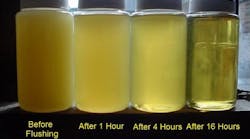If you've worked with hydraulic equipment for any length of time, it's likely that you've come across a hydraulic system with cloudy oil. Oil becomes cloudy when it's contaminated with water above its saturation level. The saturation level is the amount of water that can dissolve in the oil's molecular chemistry and is typically 200 to 300 ppm at 68°F (20°C) for mineral hydraulic oil.
Note that if hydraulic oil is cloudy it indicates that a minimum of 200 - 300 ppm of water is present. I recently audited a hydraulic system with cloudy oil that was found to contain greater than 1% (10,000 ppm) water!
A simple but effective way to dry the oil is pass a small quantity (~4 SCFM) of desiccant dry air (-40°F dew point) through the reservoir continuously.This technique is often referred to as "head space flush". Another variation of this technique involves installing a desiccant breather on the tank (it should be there already if you're serious about controlling water contamination - see below) and connecting a vacuum pump to the head space (requires a spare port - ideally as far away from the breather as possible). The beauty of this variation is its simplicity - you don't need access to a source of clean, dry compress air.
And like all other forms of contamination, preventing water ingress is cheaper than removing it from the oil. A major point of water ingression is through the reservoir breather itself. Many hydraulic system reservoirs are fitted with breather caps that allow moisture (and particles) to enter the reservoir as the fluid volume changes through thermal expansion and contraction, and/or the actuation of single-rod cylinders.
Replacing the standard breather cap with a hygroscopic breather will eliminate the ingression of moisture (and particles) through the reservoir's vent. These breathers combine a woven-polyester media that filters particles as small as 3 microns, with (usually) silica gel desiccant to remove water vapor from the air. The result is relative humidity levels within the reservoir head space that make condensation unlikely, therefore eliminating water ingression at this point.
Bottom line: allowing your hydraulic oil to get and stay wet can be a costly mistake. And to discover six other costly mistakes you want to be sure to avoid, get "Six Costly Mistakes Most Hydraulics Users Make... And How You Can Avoid Them!" available for FREE download here.
Sponsored Recommendations
May 15, 2024
March 13, 2024
March 13, 2024
March 13, 2024

